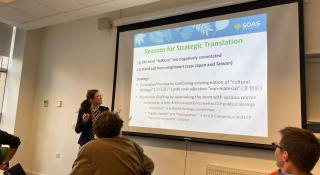Breadcrumbs navigation
A response to reviews of Worldmaking after Empire: The Rise and Fall of Self-Determination
Author Adom Getachew responds to three reviews of her book Worldmaking after Empire: The Rise and Fall of Self-Determination (Princeton University Press, 2019). The reviews were written as part of a book symposium from the Africa and International Studies Working Group.
It is a great pleasure to be read generously and incisively by your readers and even more rewarding to be afforded the opportunity to offer some responses to their questions. I thank Sarah Gray, Radia Kesseiri and Peter Brett for their engagements.
Sarah Gray’s is the first review to meditate on the cover image—Frank Bowling’s Barticaborn. A few months after the publication of Worldmaking after Empire, Barticaborn circulated on posters in London, advertising a major retrospective at the Tate Modern spanning Bowling’s 60 year career. I had seen Bowling’s work in an exhibition titled Mappa Mundi in Munich a few years earlier and was immediately take by the scale of his map paintings, a series from 1969-1971. Barticaborn was not featured there, but when I saw it I knew it would be the perfect image for the book. Its replication of Africa—the double appearing where we might locate Europe and the North Atlantic—captured in my view the scale-making quality of black internationalism and pan-Africanism. It was the worldly character of the figures at the center of my study and the broad traditions of black internationalism form which they emerged that first draw me to them and this project. Bowling and his work emerged from similar transatlantic crossings and engagements. He was part of the post-war generation of Caribbean imperial subjects who traveled to London and would as Stuart Hall, a fellow traveler, puts it in his memoir, “turn a colonial inheritance inside out.”[1]
Barticaborn represents for me the ways in which African can be the site of thinking and theorizing the world. Its colors too, which move us beyond the familiar pan-African palette of red, green and black, intimate alternative ways of mapping and envisioning the politics and promise of pan-Africanism. Finally as Gray’s review suggests, it is an opportunity to think more capaciously about the what the worldmaking of anticolonialism involved, to consider the aesthetic and cultural dimensions of this moment alongside its political and institutional instantiations. To be sure these dimensions never neatly synced up with each other. For instance, the World Festival of Black Arts, which Gray mentions, was the subject of intense contestation critiqued as a too narrow and apolitical a vision of pan-African art. For Bowling and others, the imprimatur of Senghor’s Negritude was constraining rather than liberating. Still, 1966 Festival like its successors—1969 in Algiers and 1977 in Lagos—are generative for the ways in which they point to the investments of new postcolonial states in the project of cultural decolonization and the ways artists navigating state prerogatives—at times reinforcing, at others circumventing and recasting official framings of art and culture.
In addition to pointing us to this fraught relationship between aesthetic and political dimensions of decolonization Gray’s review also illustrates how the framework of worldmaking might be stretched beyond the figures in my book to characterize other projects of decolonization. The story of Mauritius she sketches is an important reminder that the question of decolonization—even at its most elemental level of territorial sovereignty persists in the contemporary moment. It seems to me, however, that the languages and institutions we have inherited from the highpoint of decolonization no longer provide the critical and political purchase they once did. They are, as David Scott has argued, exhausted of their capacity to generate new ethical and political horizons.[2] To better attend to this exhaustion would require a more extended examination of the “fall of self-determination,” which received less sustained attention in Worldmaking.
Radia Kasseiri also extends the worldmaking I examine beyond the figures and regions of my focus. In particular she highlights the central place of Algeria and its leader Houari Boumédiène within the Non-Aligned Movement and the demand for a New International Economic Order. Kasseiri’s review implicitly puts forward the question of the justifications and stakes of boundary drawing. By focusing on the Anglophone Black Atlantic, I did not intend to displace the pivotal role of Algeria or to claim that the figures of my study—Manley, Nkrumah, Nyerere, and Williams should be conceived as the primary movers of projects like the NIEO. Instead, I sought to take a small slice of a much larger political project. On the one hand, this slice represented something about the wider Third World. As Kasseiri details “the internationalist dimension of anti-colonial nationalist politics” could be seen from Algeria as much as from Ghana. One the other hand, this slice also captured a distinct intellectual and political tradition situated within the Black Atlantic world. Especially in their collective engagements with the history of the transatlantic slave trade and its legacies and consequences for their own time, they extended anti-imperial critiques of unequal integration.
This emphasis on the Black Atlantic and on an Anglosphere, however, had the unintended consequences of diminishing other networks of collaboration and solidarity. In particular, and as Kasseiri’s attention to Algeria suggests, locating pan-Africanism primarily through the vector of the Atlantic may reify a colonial division of Africa in which the Sahara desert demarcates the north from “Black Africa.” It is not possible to take on each of the many international and transnational networks that constituted the wider Third World project. However Worldmaking might have made clearer how the actors I examined were embedded in wider formations. Another version of the project might also foreground networks that transcended imperial boundaries and specific regions.[3]
Brett’s review also considers the boundaries of Worldmaking, but rather than focus on the who of the study, he emphasizes the what. Beginning with my neglect of the global anti-apartheid struggle, he also argues that Worldmaking’s effort to distil a coherent and consistent Black Atlantic tradition of thought obscures the complex, contradictory and strategic dimensions of anticolonial worldmaking. I want to take these up in turn.
Readers familiar with the international politics of decolonization will be surprised that apartheid South Africa does not feature more prominently in Worldmaking for it was consistently a subject of UN debate and a test case for the forms of internationalism that anti-colonial nationalists advanced. Ryan Irwin’s book Gordian Knot was an important book for me as I worked on the dissertation version of my book. What I understood from Irwin’s book and found in my reading was that figures like Nkrumah viewed the apartheid state through their own priorities of expanding and universalizing sovereign equality and self-determination. In other words, though they recognized the specificity of apartheid, they did not view it as exceptional to the colonial African state more broadly. In African studies, this argument would be advanced later by Mahmood Mamdani’s classic text Citizen and Subject. Here and elsewhere, African anticolonial nationalists did critique dispossession, but they did so in a classical Marxist vein in which dispossession set the stage for the extraction and exploitation of colonial labor. Indigenous movements have taken up the mantle of self-determination since this mid-twentieth-century period of decolonization, but they have viewed dispossession as an on-going process rather than moment that sets the stage for exploitation. It was through this conceptional distinction that I sought to distinguish the critique of settler colonialism and that of alien rule.
There is however another element of what I described as anticolonial fidelity to the saltwater thesis of imperialism. This reproduction of the saltwater thesis was not simply a product of conceptual blind spots, but also a productive alibi to guard against internal demands for self-determination whether in the form decentralization or secession. This pivots us to Brett’s second major question—how the ambition to arrive at a normatively compelling picture of the anticolonial project, one that might still have purchase for us today—distorts or contorts the much more complex historical picture. As Brett notes, I have elsewhere reflected on the challenges and limits of combining historical reconstruction and normative theorizing. I have not yet found a satisfactory to this question, but I would like to venture at least three possible starting points.
First, I would now recommend staying closer to the languages of the actors themselves. A number of critics have wondered about the introduction of a neo-republican language of non-domination. Brett also worries about the effort to distil a republican tradition of the Black Atlantic. I would not say that is what I aimed at. Instead, I think the conceptual and intellectual traditions form which my actors draw were vast and diverse. I introduced the language on non-domination belatedly as a way of identifying what I took to be a common thread of critique about the inadequacy of non-intervention as a sufficient guarantee of freedom. I also hoped this language, given its wide circulation, would help contemporary reader identify the contemporary resonance of the history I reconstructed. I have since learned that it has raised more questions for readers and that ultimately it distracts from the aims of the book. Sticking with the central languages that actors themselves used from neo-colonialism to dependence, which had rich theoretical valences, might have avoided this problem.
Second, highlighting the tactical, rhetorical and strategic dimensions of the arguments advanced by anticolonial actors would help to better capture the multivocality of their arguments as well as their reception by different audiences. This is true, for instance of Brett’s examples about Nkrumah’s vision of “Union Government Now.” The argument for federation and a view of the artificiality of colonial boundaries was received and understood as an expansionist ambition even as it was endorsed by others as a vision of pan-African liberation. Attending to both dimensions, we might also consider whether and how expansionist projects that aimed at hegemony were in fact tied up with pan-Africanism.
Finally, to be able to accomplish this second task effectively, we might have to consider the scale at which we write the history of decolonization. To consider the global spanning vision of decolonization need not always require a project that traverses many regions and contexts. Instead, one might consider how the transnational or international inflects a specific location and how that location refracts wider questions about international hierarchy and its transcendence. A more geographically delimited study has the possibility, I believe, of better capturing the complex and contradictory politics of decolonization in a way that a project which seeks to span both sides of the Atlantic abstracts from such nuances. Such delimitation however need not sacrifice the ambitions of global history.[4]
Like Brett, I hope that Worldmaking encourages further examination of decolonization and contributes to the growing and vast literature on this important period of global history. This work will be advanced by an experimental spirit that more self-consciously considers scale, that takes up anti-colonialism at various registers and that considers the multiple audiences—domestic, regional, and international—which not only received anticolonial thought, but help to shape its many meanings.
References
[1] Stuart Hall & Bill Schwarz, Familiar Stranger: A Life Between Two Islands (Durham: Duke University Press, 2017), 137.
[2] David Scott, Conscripts of Modernity: The Tragedy of Colonial Englightenment (Durham: Duke University Press, 2004).
[3] For a recent example of this approach see Tim Harper, Underground Asia: Global Revolutionaries and the Assault on Empire (Cambridge: Harvard University Press, 2021).
[4] See for example Christy Thornton, Revolution in Development: Mexico and the Governance of the Global Economy (Berkeley: University of California Press, 2020).


